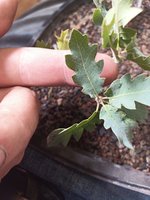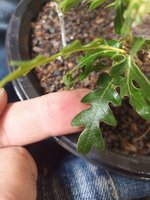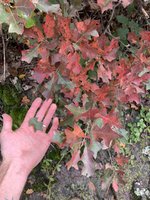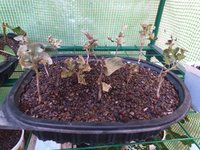ShadyStump
Imperial Masterpiece
There's a dirt bike/hiking trail just a little ways outside of town, and last summer while hiking out there I discovered an area where the native scrub oak we have here was growing tiny leaves with sharp pointed lobes.
I've been told that this sometimes happens when the trees are growing in drought conditions, but I'd never seen it before in all my years in the woods. Then, while reading up on Gambel's oak - which I had come believe these and others like them were - I learned that that species routinely hybridizes with other scrub oak varieties, and those varieties hybridize with each other so prolifically that botanists are at a loss for how to even classify them.
I've concluded that most of trees in question in my region are not true Gamble's oak, and not very likely hybrids of it, but are these other random hybrid scrub oak, so that's how I'm going to refer to them.
Then I had the thought that if these are unclassified hybrids, and since I only saw the thorn lobed trait in certain thickets in a certain place but not in neighboring thickets, then perhaps this is a trait peculiar to that particular hybrid. So I took my trusty trail mutt up that trail again, and sure enough saw the same leaf traits in the same area, just like last year. Hoping to find out for sure the nature of this trait, I went prepared to take a few cuttings...
I've been told that this sometimes happens when the trees are growing in drought conditions, but I'd never seen it before in all my years in the woods. Then, while reading up on Gambel's oak - which I had come believe these and others like them were - I learned that that species routinely hybridizes with other scrub oak varieties, and those varieties hybridize with each other so prolifically that botanists are at a loss for how to even classify them.
I've concluded that most of trees in question in my region are not true Gamble's oak, and not very likely hybrids of it, but are these other random hybrid scrub oak, so that's how I'm going to refer to them.
Then I had the thought that if these are unclassified hybrids, and since I only saw the thorn lobed trait in certain thickets in a certain place but not in neighboring thickets, then perhaps this is a trait peculiar to that particular hybrid. So I took my trusty trail mutt up that trail again, and sure enough saw the same leaf traits in the same area, just like last year. Hoping to find out for sure the nature of this trait, I went prepared to take a few cuttings...







